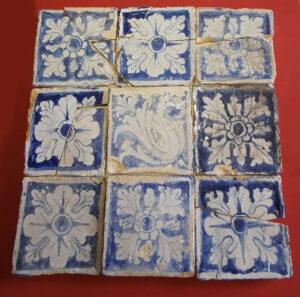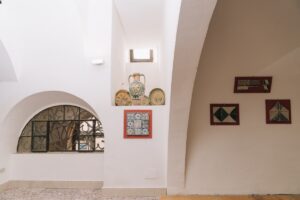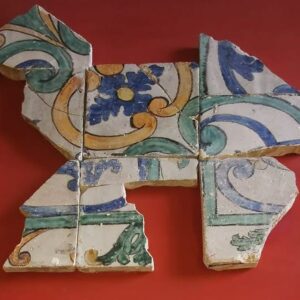 Displayed in panels or embedded in the 18th-century terracotta flooring, you can admire evidence of the ancient pavements that have existed in the buildings composing what is today an imposing Palazzo since medieval times.
Displayed in panels or embedded in the 18th-century terracotta flooring, you can admire evidence of the ancient pavements that have existed in the buildings composing what is today an imposing Palazzo since medieval times.Among the many styles, you will find blue-background tiles with white flowers typical of the 17th century and the famous “riggiole” with “handkerchief” decoration, i.e., square two-tone tiles with white and green or white and blue triangles, dating back to the early 18th century. This particular decoration was made famous worldwide by Luchino Visconti in the film “The Leopard” in the scene shot on the terrace of Villa Boscogrande, where a “wave” pattern made up of these tiles arranged to form the effect of “waves” is visible.
 It is said that Visconti himself traveled to Caltagirone to order a sufficient number of “riggiole” to pave the terrace of the villa where the scene was to be filmed. By the will of Donna Gemma Gravina di Belmonte, who personally oversees the cataloging of the collections and art pieces of the residence, panels are displayed featuring both riggiole arranged in a “wave” pattern and those forming quadrangles, as they were originally used in the Palazzo.
It is said that Visconti himself traveled to Caltagirone to order a sufficient number of “riggiole” to pave the terrace of the villa where the scene was to be filmed. By the will of Donna Gemma Gravina di Belmonte, who personally oversees the cataloging of the collections and art pieces of the residence, panels are displayed featuring both riggiole arranged in a “wave” pattern and those forming quadrangles, as they were originally used in the Palazzo.These are original pieces whose colors have maintained their original brilliance.

